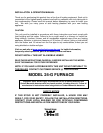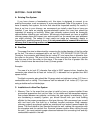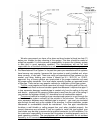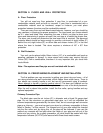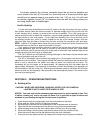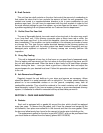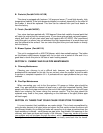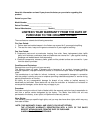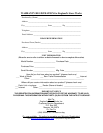For proper operation the chimney connector should be as short as possible and
never exceed a six-foot (6’) horizontal run. Horizontal runs of chimney connector pipe
should have an upward slope of one quarter of an inch (1/4”) per foot. You will need
to maintain eighteen inches (18”) of clearance from the wall and ceiling unless you
are using double wall or shielded pipe.
Hot Air Hook-Up
You are now ready to distribute air from the 8” outlet on the top of the stove into your existing
duct system. Always install the add-on-furnace’s 8” diameter supply duct to the hot air trunk line
of your existing hot air system, as close to the vent fan as possible. Thirty (30) gauge pipe or
heavier should be used to make this connection; using the least possible amount of pipe will help
the heat transfer to your duct system. Cut an eight-inch diameter hole in the main trunk line of
the existing furnace duct, which is usually located on the top of the central furnace. Slide the
eight-inch pipe from the add-on-furnace into the hole and seal the connection with duct tape.
NOTE: Install a 8” 90 degree elbow inside this hole so that air flow from central furnace will not
be directed back into the hot air pipe from the add-on furnace.
Thirty gauge or thicker black pipe should be used for the first two feet and then thirty gauge
or thicker galvanized pipe can be used to connect to the existing furnace duct. Sheet metal
screws should be used to secure each joint of pipe and an aluminum heat resistant tape can be
wrapped around each joint to give an airtight seal.
The CA-18 blower can be installed by sliding the flange on the blower into the channel track
located at the bottom and rear of the unit.
The AC-12 thermostat can be installed by plugging the 110 connection into the wall and the
opposite end into the blower. The magnetic thermal disc should be attached to the rear wall of the
stove in such a manner that the power cord does not come into contact with the stove. The
thermostat will turn the blower on at approximately 140 degrees and shut the blower down at
approximately 90 degrees. The frequency of the blower cycle will be affected by the placement of
the thermostat on the rear of the unit. Mounting the thermostat closer to the blower will allow the
blower to come on less frequently. We recommend the thermostat be placed in the center of the
rear wall as a starting point.
SECTION IV: OPERATING INSTRUCTIONS
A. Building a Fire
CAUTION: NEVER USE KEROSENE, GASOLINE, DIESEL FUEL OR CHARCOAL
LIGHTER FLUID TO LIGHT OR RE-KINDLE A FIRE.
NOTICE: Your new unit and the connector pipe may smoke for a short period of time. This
is called “cooking out” and is no cause for alarm. It is a good idea to open all doors and
windows in your dwelling during the first few hours of operation.
1. Place several wads of crushed paper over the entire bottom of the stove.
2. Place small dry sticks (kindling) of wood on the paper.
3. Be absolutely sure there are no combustibles in the immediate area of the stove.
4. Open the two cast iron dampers on the door by turning them counterclockwise.
5. Ignite the paper and leave the door cracked open until the fire is burning freely.
6. Once the kindling is burning freely, add several pieces of split dry wood to the fire.
Allow this wood to start burning well before closing the door completely.
7. Close the door and adjust the cast iron dampers on the door by turning them clockwise.



